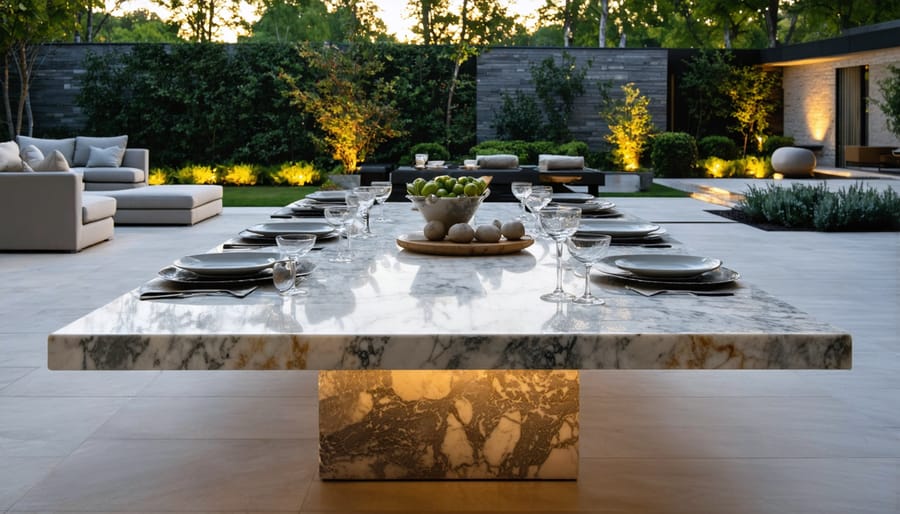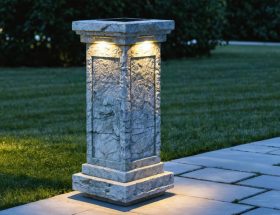Natural stone tables stand as timeless masterpieces, merging raw geological beauty with functional elegance in both indoor and outdoor spaces. Each table tells a unique story through its distinctive veining, color variations, and crystalline structures – patterns crafted by millions of years of natural forces. From the sophisticated gleam of marble and the earthy warmth of travertine to the rugged character of granite, these substantial pieces transform ordinary dining and living spaces into extraordinary gathering places.
Beyond their striking aesthetics, natural stone tables offer unmatched durability and presence. Their solid construction withstands decades of use while developing a rich patina that enhances their character over time. Unlike mass-produced alternatives, these tables serve as investment pieces that often appreciate in value, becoming family heirlooms that bridge generations.
Whether anchoring a grand dining room, serving as a statement piece in a garden setting, or providing a sophisticated focal point for outdoor entertainment areas, natural stone tables blend seamlessly with diverse design styles – from minimalist modern to classic traditional. Their versatility and enduring appeal make them not just furniture pieces, but architectural elements that define and elevate spaces.
Popular Natural Stone Options for Outdoor Tables
Granite: The Durability Champion
When it comes to natural stone tables, granite stands as the undisputed champion of durability. This igneous rock’s exceptional hardness and density make it virtually impervious to scratches, heat, and everyday wear. Available in a wide array of stone finish options, from polished to honed surfaces, granite tables combine practicality with striking natural beauty.
Granite’s crystalline structure provides inherent strength that withstands heavy use, making it ideal for both indoor dining tables and outdoor entertainment spaces. Its non-porous nature, when properly sealed, resists staining and requires minimal maintenance beyond routine cleaning. The material’s heat resistance allows it to handle hot serving dishes without damage, while its cool surface is perfect for activities like baking preparation.
Each granite table tells a unique story through its distinctive patterns and color variations, from dramatic swirls to subtle speckles. This natural variation ensures that no two pieces are exactly alike, offering exclusivity in design while maintaining uncompromising functionality. For those seeking a lifetime investment in furniture, granite delivers both aesthetic appeal and unmatched durability.
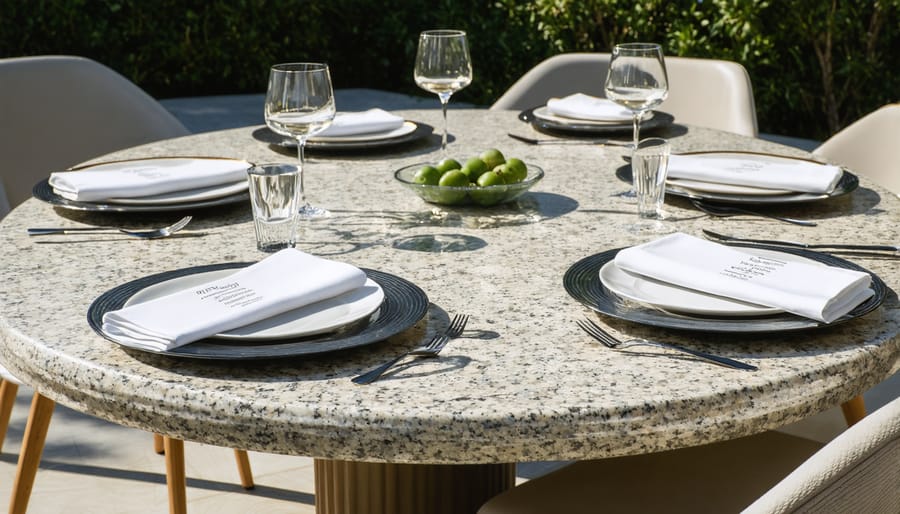
Marble: Elegant Yet Practical
Marble’s timeless elegance has made it a coveted choice for outdoor tables, offering a perfect blend of sophistication and functionality. The stone’s distinctive veining patterns and broad color spectrum, ranging from classic white Carrara to dramatic black Marquina, create unique focal points in any outdoor setting.
While marble exudes luxury, it requires thoughtful consideration for outdoor use. The material is more porous than some other natural stones, making it somewhat susceptible to staining and etching from acidic substances. However, modern sealants and proper maintenance can significantly enhance its durability and resistance to outdoor elements.
Weight is another important factor, as marble tables provide excellent stability in outdoor environments, particularly in windy conditions. The stone’s natural cooling properties make it comfortable to touch even in direct sunlight, unlike metal furniture that can become uncomfortably hot.
For best longevity, position marble tables under covered areas when possible and clean them regularly with pH-neutral cleaners. With proper care, a marble outdoor table can serve as both a practical dining surface and an enduring piece of functional art that enhances your outdoor living space.
Limestone and Sandstone Options
Limestone and sandstone offer more casual, earthy alternatives to marble and granite for outdoor stone tables. Limestone’s warm, natural tones range from cream to golden buff, creating an inviting Mediterranean atmosphere. Its porous nature develops a distinctive patina over time, adding character to your outdoor space. Sandstone tables feature striking layered patterns and come in colors from rust red to desert tan, making them ideal for rustic or southwestern-style settings. While both materials are softer than granite, they’re still durable enough for outdoor use when properly sealed. These stones are typically more budget-friendly than premium options, though they require regular maintenance to prevent staining and weather damage. Their textured surfaces and natural variations make each table unique, perfect for those seeking an authentic, lived-in aesthetic.
Design Styles and Applications
Contemporary Minimalist Designs
Contemporary minimalist design embraces clean lines and uncluttered aesthetics, making natural stone tables perfect centerpieces for modern spaces. Today’s designers are incorporating sleek stone slabs with minimal structural supports, creating striking pieces that appear to float effortlessly. These tables often feature monolithic designs that showcase the stone’s natural beauty while complementing modern outdoor space design principles.
Popular minimalist configurations include thin marble tops supported by geometric metal bases, streamlined granite consoles with glass accents, and cantilevered limestone surfaces that challenge traditional table structures. The focus remains on highlighting the stone’s inherent patterns while maintaining visual simplicity.
Neutral color palettes dominate this style, with designers favoring stones in whites, grays, and blacks. However, subtle veining and natural variations add depth without compromising the minimalist aesthetic. Edge treatments tend toward straight, crisp profiles rather than ornate details, while surface finishes often feature honed or leather-textured treatments that provide sophisticated, understated appeal.
Traditional and Mediterranean Influences
Natural stone tables have long been emblematic of both Mediterranean and traditional design aesthetics, drawing inspiration from ancient Roman and Greek architecture. These enduring pieces often feature classic elements like carved pedestals, scrollwork details, and substantial proportions that echo the grandeur of historical monuments and villas.
In Mediterranean design, stone tables frequently incorporate warm, sun-kissed tones of travertine and limestone, reflecting the natural landscape of coastal regions. Circular and oval shapes dominate this style, often supported by elegant curved bases or classical columns. These designs emphasize outdoor living and gathering spaces, perfectly suited for al fresco dining and entertainment.
Traditional approaches typically showcase more formal elements, with rectangular or square tables featuring precise edges and symmetrical designs. Marble remains a prevalent choice in traditional settings, particularly varieties with distinctive veining patterns that add sophistication to formal gardens and covered patios.
Both styles share a commitment to durability and timeless appeal, often incorporating design elements like rope twists, laurel wreaths, or geometric patterns that have remained relevant for centuries. These classical influences continue to inspire modern interpretations while maintaining their authentic character and enduring charm.
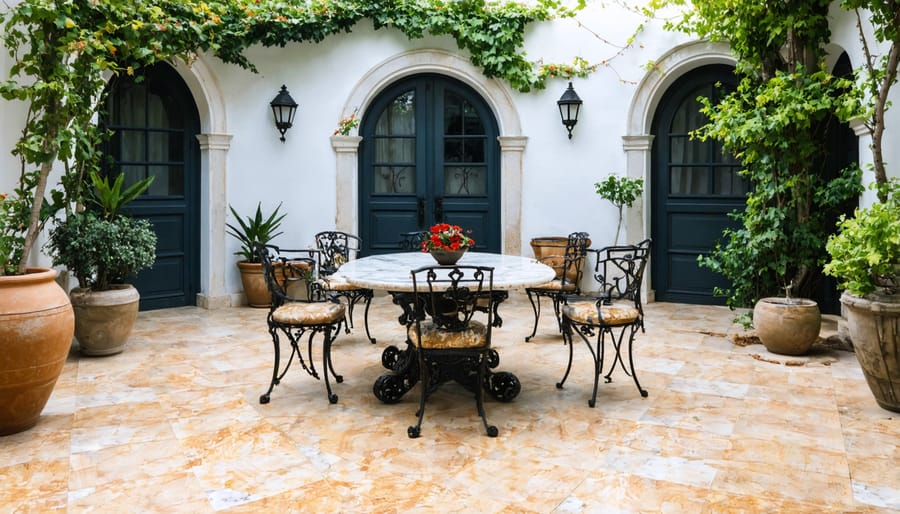
Custom and Bespoke Options
Natural stone tables offer unparalleled opportunities for personalization, allowing you to create pieces that perfectly match your vision and space requirements. Through custom stone designs, you can specify every aspect of your table, from dimensions and shape to edge profiles and surface finishes.
Choose from various stone cuts and patterns, including book-matched slabs for dramatic visual impact or continuous veining for seamless flow. Edge treatments range from simple straight edges to elaborate profiles like bullnose, beveled, or waterfall designs. Surface finishes can be customized to achieve your desired look and functionality, whether it’s a high-gloss polish, leather finish, or textured honed surface.
Unique features can be incorporated to enhance both aesthetics and functionality. Consider integrated lighting systems, custom inlays using contrasting stone varieties, or mixed material combinations such as stone tops with metal or wood bases. For dining tables, special considerations like built-in lazy Susans or cooling sections for outdoor entertaining can be included.
Working with experienced craftsmen ensures your custom piece not only meets your aesthetic preferences but also maintains structural integrity and practicality. They can advise on the best stone varieties for your specific application and help create design solutions that optimize both beauty and functionality while respecting the natural characteristics of your chosen stone.
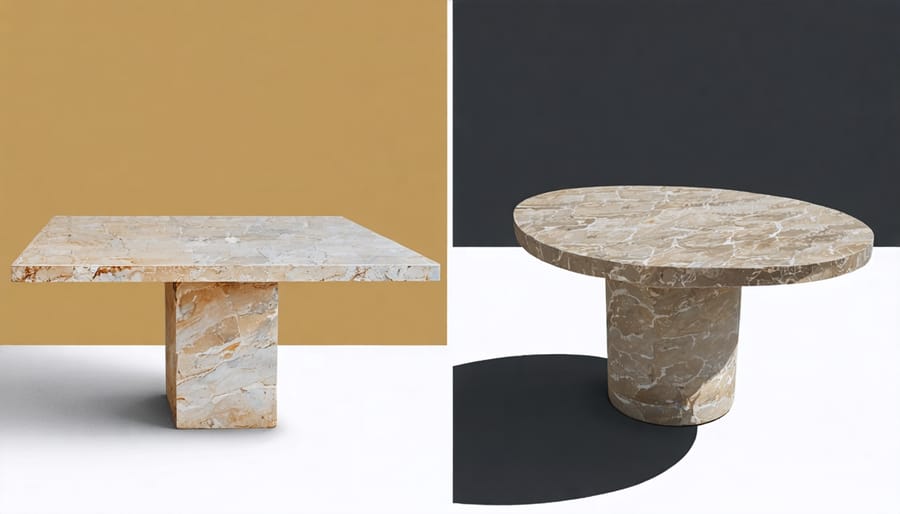
Maintenance and Care
Seasonal Care Requirements
Natural stone tables require specific care throughout the changing seasons to maintain their beauty and durability. During spring, inspect your table for any winter damage and clean thoroughly using pH-neutral stone cleaners to remove accumulated dirt and debris. Apply a fresh coat of sealer if water no longer beads on the surface.
Summer demands regular cleaning to prevent staining from outdoor activities and BBQ spills. Keep the table covered during intense heat to prevent fading and protect against thermal shock from sudden temperature changes. Remove bird droppings promptly as they can be acidic and damage the stone’s surface.
In autumn, clear fallen leaves frequently to prevent tannin stains and moisture retention. Consider using furniture covers when not in use to protect against wet conditions and falling debris. Before winter, apply an additional layer of sealer for extra protection against freeze-thaw cycles.
Winter requires the most vigilant care. If possible, store your stone table indoors or under a weatherproof cover. For tables that must remain outside, ensure proper drainage to prevent water pooling, which can lead to cracks when frozen. Never use de-icing salts near your stone table, as they can cause severe surface damage.
Regardless of season, always use coasters and placemats to prevent direct contact with hot items, cold drinks, or acidic foods. Quick response to spills and regular maintenance will ensure your stone table remains beautiful throughout the year.
Protection and Treatment Options
Protecting your natural stone table is essential for maintaining its beauty and extending its lifespan. Professional stone sealing techniques create an invisible barrier against stains, moisture, and everyday wear. For optimal protection, apply a high-quality penetrating sealer specifically formulated for your stone type every 12-24 months, depending on usage and exposure.
Protective covers are invaluable when the table isn’t in use, especially for outdoor settings. Choose breathable, water-resistant covers that prevent moisture buildup while protecting against UV damage, rain, and debris. For indoor tables, consider using placemats and coasters to prevent scratches and stains from hot dishes and beverages.
Preventive measures include immediately wiping spills, avoiding acidic cleaners, and using pH-neutral stone cleaners for routine maintenance. Place felt pads under decorative items to prevent scratching, and never drag objects across the surface. For tables with natural fissures or veining, extra care during cleaning helps preserve these distinctive characteristics.
Regular inspections can identify potential issues before they become serious problems. Check for signs of wear in the sealant, particularly in high-use areas. If you notice the stone becoming more absorbent or developing dull spots, it’s time to reapply sealer. Professional restoration services can address more significant damage and maintain your table’s original beauty.
Investment and Value Considerations
Price Range and Quality Factors
Natural stone tables vary significantly in price, typically ranging from $800 to $15,000 or more, depending on several key quality factors. The size and thickness of the stone are primary cost determinants, with larger slabs and thicker cuts commanding higher prices. Material choice also plays a crucial role – while granite and limestone offer more affordable options, rare marble varieties and onyx can push prices into premium territory.
Quality indicators include stone density, color consistency, and the presence of natural patterns. High-quality stones display uniform coloring throughout, with minimal unwanted variations or imperfections. The finish quality – whether polished, honed, or textured – should be even and professionally executed across the entire surface.
Manufacturing precision is another essential factor. Premium stone tables feature clean, precise cuts, especially around edges and corners. The support structure, whether metal or stone, should complement the tabletop both aesthetically and functionally. Look for tight seams and proper reinforcement in larger pieces.
Certification and sourcing documentation can justify higher prices. Tables made from sustainably quarried stone with traceable origins often cost more but offer assurance of quality and ethical production. The fabricator’s reputation and warranty terms also influence pricing, with established manufacturers typically charging more for their expertise and quality guarantees.
When evaluating options, consider the stone’s durability for its intended use. Some less expensive stones might require more frequent maintenance or show wear more quickly, potentially leading to higher long-term costs.
Long-term Value and Durability
Natural stone tables represent one of the most enduring investments in outdoor and indoor furniture, offering exceptional longevity that can span generations when properly maintained. The inherent durability of materials like granite, marble, and quartzite makes these tables resistant to daily wear, extreme weather conditions, and the test of time. This commitment to timeless natural stone design translates into furniture pieces that maintain their beauty and functionality for decades.
Unlike manufactured materials, natural stone develops a unique patina over time, enhancing its character while maintaining structural integrity. Granite tables, for instance, can withstand temperatures from freezing to extreme heat without showing signs of degradation. Marble, though slightly more delicate, remains stable and beautiful for generations when properly sealed and maintained.
The long-term value of stone tables extends beyond durability to include appreciating aesthetic appeal and potential investment returns. Well-maintained stone pieces often become family heirlooms, their value increasing over time as natural stone becomes increasingly precious. This lasting quality makes them particularly cost-effective despite higher initial investment, especially when compared to furniture that requires frequent replacement.
Additionally, stone tables require minimal maintenance over their lifetime, resulting in lower long-term care costs and effort. Their resistance to scratches, stains, and environmental damage means they remain functional and attractive with basic care, making them an excellent choice for both residential and commercial settings.
Natural stone tables represent a timeless investment that combines functionality, durability, and aesthetic appeal. Throughout this guide, we’ve explored the diverse world of natural stone tables, from the elegant veining of marble to the rugged beauty of granite and the understated charm of limestone. These pieces not only serve as functional furniture but also as striking focal points that can transform any space.
When selecting a natural stone table, remember to consider your specific needs, including the table’s intended use, location, and exposure to environmental elements. The choice of stone material should align with both your aesthetic preferences and practical requirements. While marble offers unmatched elegance, granite provides superior durability, and travertine brings unique character to outdoor spaces.
Proper maintenance is crucial for preserving your stone table’s beauty and extending its lifespan. Regular cleaning, sealing, and protection from harsh elements will ensure your investment continues to enhance your space for years to come. While natural stone tables may require a higher initial investment compared to other materials, their longevity, durability, and timeless appeal make them a worthwhile choice for both residential and commercial applications.
Whether you’re furnishing a dining room, creating an outdoor entertainment area, or designing a commercial space, natural stone tables offer endless possibilities for achieving your desired aesthetic while providing practical functionality. Choose wisely, maintain diligently, and enjoy the enduring beauty of your natural stone table for generations to come.

